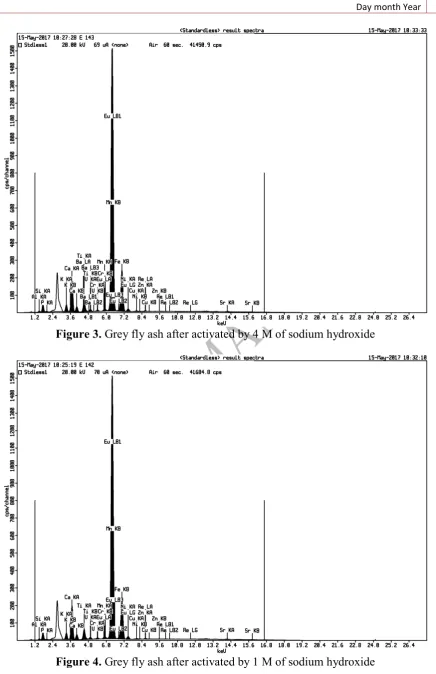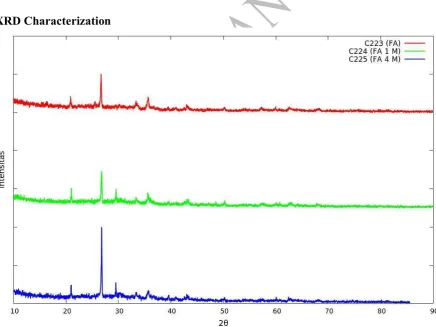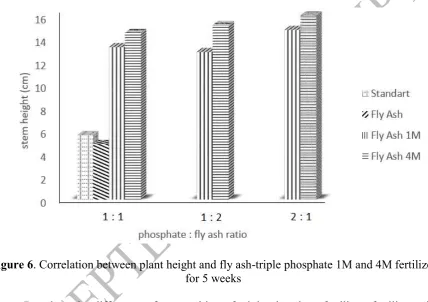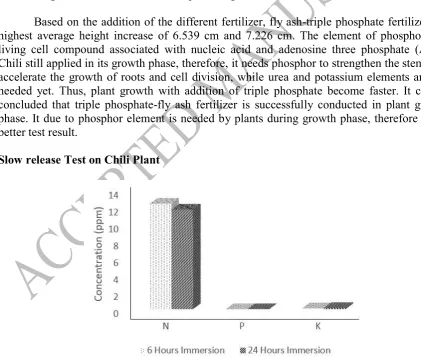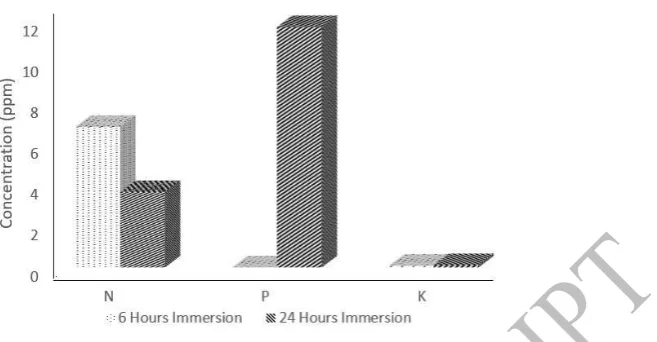The journal homepage www.jpacr.ub.ac.id p-ISSN : 2302 – 4690 | e-ISSN : 2541 – 0733
NPK Fertilizer with Slow Release Fly Ash
Nadhira Izzatur Silmi1, Fidela Azaria Antasari1, Della Afriyana1, Ridha Dini Rahmawati1, Ilham Sidik1 and Sri Wardhani1*
1
Department of Chemistry, Faculty of Mathematic and Natural Sciences,Brawijaya University
*
Received day month year; Accepted day month year (will be given)
ABSTRACT
Fly ash is a residual solid combustion carried by gas. The content of fly ash is similar to zeolite. Hence, fly ash can be used instead of zeolite for fertilizer carrier. Slow release test result was revealed that N element has higher release level. The activity plant test was conducted on chili plant using parameter variation of fertilizer composition and plant height. Based on the research result, triple phosphate-fly ashfertilizer in comparison 2:1 gave the best result.
Key word: fertilizer, slow release, fly ash, NPK, granule
INTRODUCTION
Clean water availability is a basic needs and becomes a limited resource on the earth due to industrial include fertilizer can produce residual products which can pollute the water. In some areas, where water is abundant, clean water can be limited due to people behavior that produces pollutants. Fly ash can be a solution to reduce residual from fertilizer [1]
Fly ash is residual solid combustion carried along with exhaust gases and captures by air controller. Fly ash contains many silica and alumina mineral which both have pozzolan properties that have no adhesive properties. Fly ash compose of Al2O3, SiO2, Fe2O3, CaO, MgO, Na2, and SO. By using fly ash granules, silica can react with water and affordadhere properties [2].
Fly ash can be applied for construction. Itis also used as a mineral in PCC (Precipitated Calcium Carbonate) for almost 60 years which is the largest use of single fly ash. This also can be used as a material for Portland cement production and a mixture of Portland-pozzolan cement. In addition, fly ash has also been used as replacement mineral filler on asphalt mixture which consists of particles less than 0.075 mm (200mesh). It used to fill the void in a paving mixture and increase binding cohesion (cement asphalt) and stability of asphalt mixture. Therefore, fly ash has potential for daily life [3].
Zeolite is a mineral aluminosilicate hydrate. Zeolite has a unique structure by the presence of alumina groups (AlO4-) and silica group (SiO4) interconnected by oxygen atoms form a three-dimensional dimensional framework [5]. Fly ash and zeolite has similar content. Zeolite and fly ash both contain Al2O3, SiO2, Fe2O3, CaO, and MgO which can be as superabsorbent with low cost of production. Zeolite usually used as fertilizer carrier and also fly ash according to the theory[6].
Before fly ash is used, it need to be activated with sodium hydroxide. The reaction of a solid aluminosilicateusing a highly concentrated aqueous alkali hydroxide produces a synthetic alkaline aluminosilicate material. It depends on the raw materials and processing condition used, alkali-activated binders may feature high compressive strength, low shrinkage, acid and fire resistance, and low thermal conductivity [7]. The alkali activation of fly ashes produces the dissolution of the glassy component (aluminosilicate) and formation from dissolved species of amorphous alkaline aluminosilicate gels. The amorphous compound formed displays the same characteristics of zeolites precursors during alakaline activation of metakaoilin[8]
Fertilizer that mostly applied nowadays is the type of NPK, which is macro element for plant. However, recently the manufacture of NPK fertilizer modified with granules form due to powder or liquid form can easily solved in water before it applied by the plant. it can cause growth of water hyacinth (Eichhornia crassipes) in the water because of high concentration of phosphor[9].
Fertilizer using slow release form can optimize nutrient absorption to the plant with time and amount that needed by plant. Fly ash slow release can maintain nutrient in soil. Moreover, slow release fertilizer more efficiently used than using conventional method[10].
EXPERIMENT
Chemicals and instrumentation
Materials used are grey fly ash from Paiton Indonesia. Urea, Potassium Chloride (KCl), triple phosphate, sodium hydroxide 48%, ethanol 70%, distilled water, molasses, and chili plant. Instrument used are XRF and XRD brand: Analytical, type: Expert Pro.
Procedure reaction
Preparation and fly ash activation
100 grams of fly ash in a beaker glass 500 mL was added by 300 mL of sodium hydroxide 48% by varying concentration of 4M and 1M and stirred for 6 hours. The precipitate was filtered and washed using distilled water until filtrate pH reached 7. The precipitate was dried in an oven under 100oC.
Preparation of NPK fly ash slow release
Each of urea, triple phosphate, and potassium chloride fertilizer was mixing with fly ash by ratio of 1:1, 1:2, and 2:1 in 250 mL beaker glass. Then the mixture was added by ethanol 70% 5 mL and stirred for 2 hours. The precipitate was filtered and dried in an oven at 80oC.
Granulation
NPK Fertilizer Activity Test Fly Ash Slow Release on Chili Plant
5-days-old chili plants grown in tray and fertilized which is put into soil. After one week, chili plant transferred to polybag and fertilized again. Measurement of height and
number of leaf’s plant is conducted every once a week starting from planting of chili plant.
Fly ash Characterization with XRF Analysis
XRD analysis was performed on grey fly ash and fly ash activated in concentration of 4 M and 1 M samples to determine the oxide composition and presence of compounds with specific structure in samples at an angle 10o-90o. This analysis was conducted in Mineral Laboratory and Advance Material Central Lab University of Malang.
Testing of slow release of NPK Fly Ash Fertilizer
The slow release test of NPK fly ash fertilizer was conducted by 2 methods, such as Atomic Absorption Spectrometry (AAS) and spectrophotometry using Kjeldal-Nessler solvent. This test was undertaken by varying immersion solution for 6 hours and 12 hours in each concentration of 1 M and 4 M.
RESULT AND DISCUSSION XRF Characterization
Primary components of fly ash are silica (SiO2), alumina (Al2O3), iron oxide (Fe2O3) with varying amounts of carbon, calcium, magnesium, and sulphur. There are two general classes of fly ash, class F (contain less than 7 wt.% of CaO) and class C (contains more 5-30 wt.%). In general, fly ash has a hydrophilic surface and porous structure [11].
Figure 2. XRF result of yellow fly ash non activation
Table 1. XRF result of grey and yellow fly ash
Composition Concentration (%)
Grey Yellow
Fe 47.49 47.89
Si 22.6 9.67
Al 9.7 3.6
K 2.9 12
Ca 12.8 29.4
Figure 3. Grey fly ash after activated by 4 M of sodium hydroxide
Table 2. XRF Result of activated fly ash
Composition Concentration (%)
1M 4M
Fe 54.49 52.8
Si 17.9 18.8
Al 7.4 8.2
K 2.58 2.66
Ca 11.1 11.1
Activation using sodium hydroxide was aimed to dissolve Si and Al components without dissolving metal contained in fly ash as micro unsure that required by plants. Based on the XRF result, there are Si and Al component dissolved in activation process. Before activation, composition of Si is 22.6%, but after activation it decreased to 17.9% and 18.8% in concentration of 1 M and 4 M, respectively. Al content before activation is 9.7%, after activation it decreased to 7.4% and 8.2%, in concentration of 1 M and 4 M, respectively. Fly ash pores clogged by Si and Al will open, indicated with decreased of Al and Si. Hence, the pores of fly ash are loose, lead to increase the carrying ability of fly ash. Activated fly ash has fast setting and rapid strength development properties and it is also used for the immobilization of toxic waste [12].
XRD Characterization
Figure 5. XRD of Fly Ash before Activation and After Activation
compared to JCPDS, fly ash comprised quartz form of Si, hematite and magnetite form of Fe, and calcite form of Ca.
Table 3. Comparison JCPDS of SiO2 Quartz and XRD of Fly Ash
JCPDS SiO2
Table 4. Comparison JCPDS of Fe2O3 Hematite and XRD of Fly Ash
JCPDS Fe2O3
Based on XRD result, there is no significant change of 2 between activation and non activation of fly ash. This shows that activated alkali does not change the crystal structure. Comparison of SiO2 quartz and Fe2O3 hematite JCPDS and XRD of fly ash indicate the same value of 2 which means fly ash comprised SiO2 with quartz structure and Fe2O3 with hematite structure. Ayanda (2012)[13] reported the diffractogram of fly ash showed that FA consists mainly of crystalline minerals mullite (Al6Si2O13) and quartz (SiO2) with large characteristic peak of quartz (SiO2).
Manufacture of Slow release fertilizer
The activated fly ash was mixed by potassium chloride, urea, and triple phosphate in ratio of 1:1, 1:2, and 2:1. The granulation done was conducted using molasses as adhesive. Fertilizer fly ash-urea granule has a different size and easily breakable in drying treatment. This is due to the texture of mixed fertilizer fly ash-urea is very dry, and also due to the content of CO2 inside urea. Thus, in the making of granules is not easy and need for compaction using the hand.
The mixture of fly ash-triple phosphate produces a product that has a uniform shape when it is granulated. Physically, it is not easily broken. Texture of fly ash-triple phosphate is slightly wet, Hence, it was easy in process of granulation using a drops of molasses. This is due to the Ca content of triple phosphate (Ca(H2SO4)). Potassium content has high density properties. In addition, the content of phosphor and calcium has low solubility to water makes this structure became hard.
NPK Fertilizer Activity Test Fly Ash Slow Release on Chili Plant
Each fertilizer variation was applied to chili plant once a week which is one variation for six chili plant. The result of plant growth are obtained based on the high plant from week 1 to week 5.
Figure 6. Correlation between plant height and fly ash-triple phosphate 1M and 4M fertilizer for 5 weeks
Figure 7. Correlation between plant height and various fertilizer for 5 weeks
Based on the addition of the different fertilizer, fly ash-triple phosphate fertilizer has highest average height increase of 6.539 cm and 7.226 cm. The element of phosphor is a living cell compound associated with nucleic acid and adenosine three phosphate (ATP). Chili still applied in its growth phase, therefore, it needs phosphor to strengthen the stem and accelerate the growth of roots and cell division, while urea and potassium elements are not needed yet. Thus, plant growth with addition of triple phosphate become faster. It can be concluded that triple phosphate-fly ash fertilizer is successfully conducted in plant growth phase. It due to phosphor element is needed by plants during growth phase, therefore it has better test result.
Slow release Test on Chili Plant
Figure 9. Slow release result of fly ash 4M in immersion for 6 and 24 hours
Fly ash 4M with immersion for 6 hours in aquadest, N element released 12.42 ppm, while P element released 0 ppm. However, fly ash with immersion for 24 hours, P element released still 0 ppm, while K element only released 0.14 ppm. In addition, slow release test for 1M with immersion for 6 hours in aquadest, N element easily release with 6.85 ppm, while P released 0 ppm. However, fly ash in 24 hours immersion, P element released 117 ppm, while K element only 0.11 ppm.
The lower concentration, it may lead to control easily the release of nutrients according to time and the number of plants required which can hold nutrients in the soil. Hence, fly ash can be applied as a good fertilizer carrier. The undetectable elements of release speed are due to the absence of fertilizer release in 6-24 hours. It signifies better release ability. Thus, P and K element have better release capabilities than N.
CONCLUSION
The activation of fly ash using sodium hydroxide can open or enlarge the pore size. 2:1 ratio of triple phosphate with 4M fly ash has better result due to the more phosphor element carried by fly ash. Thus, the elements received by plants are also increasingly shown from plant growth. The slow release test result indicated that N element has higher release level than P and K.
ACKNOWLEDGMENT
[6] Donahoe, Rona J, and J.G.Ltou, Clays Clay Miner.,1984, 32(6), 433-443.
[7] Palomo, a., Ana, F-J., Alkaline Activation, Procedure for Transforming Fly Ash into New Materials. Part I: Applications, World of Coal Ash Conference, 2011, Denver, USA.
[8] Palomo, A, Santiago, A., Ana, F-J., J Am Ceram Soc.,2004, 87(6), 1141-1145. [9] Pratomo, K. R., Jurnal Zeolit Indonesia, 2009, 8(2), 83-88.
[10] Nainggolan, Ganda Darmono, Jurnal Zeolit Indonesia, 2009, 8(2), 89-96. [11] Sarkar, A., Anupama, S., Agrawal, S., B., Bull. NIE, 2012, 23, 1-12. [12] Subhash, V, P., Yuwaraj, M, G., Sanjay, S, J., IJMS, 2014, 2014, 1-6.


